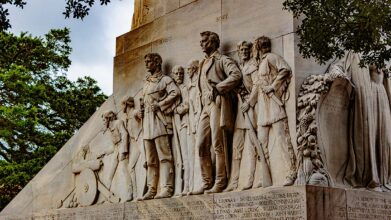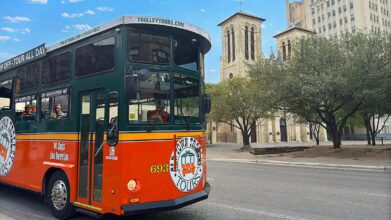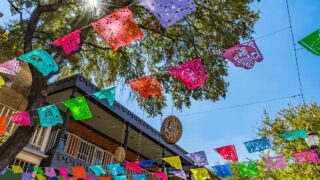The Alamo
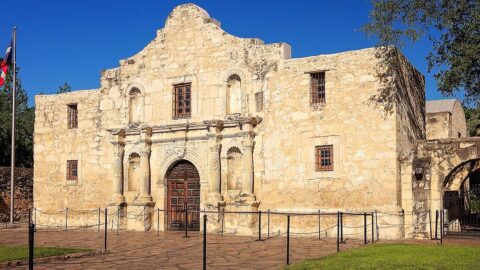
The Alamo is a historic site located in San Antonio, Texas. It was originally built as the Mission San Antonio de Valero in 1718 and was later converted into a military fort known as the Alamo in the late 18th century. In 1836, the Alamo became an important location during the Texas Revolution. A small group of Texan defenders, including famous figures such as Davy Crockett and James Bowie, held off the Mexican army for 13 days before ultimately succumbing to defeat. This event became known as the Battle of the Alamo and is considered a defining moment in Texas history.
History of the Alamo
In 1835, during the Texas Revolution for independence from Mexico, Texan rebels took control of the Alamo and used it as a fortress against Mexican troops. A pivotal moment in the revolution, the Battle of the Alamo lasted for 13 days before ultimately resulting in defeat for the Texans. The name “Alamo” comes from the Spanish word for “cottonwood,” referencing the trees that surrounded the fort when it was first built. After Texas gained independence from Mexico in 1836, the Alamo was used as a military outpost for several years before being abandoned and falling into disrepair. In the late 19th century, the Alamo was restored and designated as a state historic site. Today, it is open to visitors as a museum and memorial to the brave men who fought and died during the Battle of the Alamo. The iconic image of the Alamo, with its distinctive façade and Lone Star flag flying proudly, has become a symbol of Texan pride and resilience. While the Alamo is most well-known for its role in the Texas Revolution, it holds significant cultural and historical importance beyond this event. It has served as a Spanish mission, a military outpost, and even a hospital during the Civil War. The Alamo has witnessed many chapters of American history and continues to be a popular tourist destination, drawing in millions of visitors each year.
Visiting the Alamo
The Alamo Church
The Alamo Church, also known as the Mission San Antonio de Valero, is the most recognizable building on the Alamo grounds. It was founded in the 18th century by Spanish missionaries and served as a religious and social center for the local community. During the Texas Revolution in 1836, the Alamo Church was famously defended by a small group of Texan soldiers against the much larger Mexican army. Although they were ultimately defeated, the brave defenders of the Alamo Church have become legendary figures in Texas history and are often referred to as “The Heroes of the Alamo.” The Alamo Church is a popular tourist destination and serves as a symbol of Texan independence and bravery. The iconic building is recognized for its distinctive architecture, including the bell-shaped façade and classic Spanish-style arches. Visitors can explore the church’s rich history through various exhibits and artifacts, including weapons and personal belongings of the defenders.
Long Barrack Museum
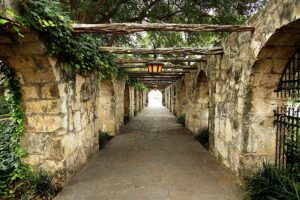 The Long Barrack Museum is the oldest building on the historical Alamo site. It was originally constructed as a two-story convent and served as the living quarters and offices of the Spanish missionaries. During the Battle of the Alamo, many of the Texas soldiers withdrew here, where they made a stand against the Mexican army. The Long Barrack Museum serves as a museum and educational center, preserving the history and cultural significance of the Alamo. The museum features exhibits on various aspects of Texas history, including the Spanish colonial period, the mission system, and the Battle of the Alamo. Visitors can explore artifacts, interactive displays, and multimedia presentations to learn more about this pivotal moment in Texas history. The Long Barrack also serves as a memorial to the individuals who fought and died at the Alamo. The names of those who lost their lives defending the fort are inscribed on a wall inside the building.
The Long Barrack Museum is the oldest building on the historical Alamo site. It was originally constructed as a two-story convent and served as the living quarters and offices of the Spanish missionaries. During the Battle of the Alamo, many of the Texas soldiers withdrew here, where they made a stand against the Mexican army. The Long Barrack Museum serves as a museum and educational center, preserving the history and cultural significance of the Alamo. The museum features exhibits on various aspects of Texas history, including the Spanish colonial period, the mission system, and the Battle of the Alamo. Visitors can explore artifacts, interactive displays, and multimedia presentations to learn more about this pivotal moment in Texas history. The Long Barrack also serves as a memorial to the individuals who fought and died at the Alamo. The names of those who lost their lives defending the fort are inscribed on a wall inside the building.
Living History Encampment
The Living History Encampment is an interactive and immersive experience that brings history to life through demonstrations, reenactments, and hands-on activities. This educational area allows visitors to step back in time and get a glimpse of what life was like during different historical periods, from Colonial America to the Civil War era. Visitors to the Living History Encampment can see firsthand how people dressed, cooked, fought, and lived during these pivotal moments in history. They not only get to witness demonstrations of historical events but also have the opportunity to actively participate in them. They can learn skills like blacksmithing, candle making, and even musket firing. These activities offer a hands-on experience that allows visitors to fully immerse themselves in the past.
Alamo Exhibit
The Alamo Exhibit was established to showcase the history and significance of the Battle of the Alamo, a pivotal event in Texas’s fight for independence. The exhibit features various artifacts, documents, and multimedia presentations that bring the story of the Alamo to life. Visitors can explore different sections of the exhibit, including a replica of the Alamo mission itself, and learn about the people who were involved in the battle. One of the highlights of the Alamo Exhibit is its collection of over 200 historical artifacts. These include weapons used by both sides during the battle, uniforms worn by soldiers, and personal belongings of notable figures such as Davy Crockett and William Travis. The exhibit also features a 4D theater that offers an immersive experience of the battle, complete with special effects and sensory elements. Visitors can also explore the rich culture and heritage of Texas through various exhibits and displays.
16 Pounder Cannon
The 16 Pounder Cannon, also known as a “saker” or “long gun,” was an artillery piece that was widely used during the 18th and 19th centuries. It was developed in England in 1716 by the Royal Arsenal at Woolwich. The cannon weighed approximately 3,400 pounds and had a bore diameter of 4.62 inches. During the American Revolutionary War, the 16 Pounder Cannon was used extensively by both British and American forces. In fact, one of these cannons played a crucial role in the Battle of Saratoga in 1777, helping to secure a victory for the Americans. The cannon’s impressive range and firepower proved to be a valuable asset on the battlefield. The 16 Pounder Cannon’s influence extended beyond its use in the American Revolutionary War. It was also utilized in other significant historical events, such as the Battle of San Antonio during the Texas Revolution. The cannon, known as “El Niño de Atocha” or The Child of Atocha, played a vital role in this battle and is now on display at the San Antonio Missions National Historical Park in Texas. This cannon serves as a powerful symbol of the significant role artillery played in shaping American history. It stands as a reminder of the bravery and sacrifices made by soldiers during times of conflict and highlights the technological advancements that have shaped warfare throughout history.
Statues of Heroes
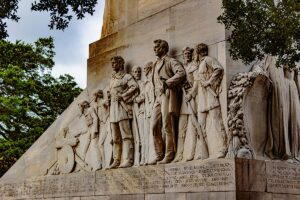 These statues of various heroes and historical figures serve as a reminder of their contributions to society and inspire us to learn more about them. One notable statue is the Alamo Cenotaph, also known as The Spirit of Sacrifice. It is a 58-foot-tall monument dedicated to the heroic defenders of the Alamo who fought during the Battle of 1836. The Alamo Cenotaph is an iconic symbol of Texas history and represents the bravery and sacrifice of those who gave their lives for freedom. Another significant statue in San Antonio is the “Torch of Friendship.” This 65-foot-tall monument represents the strong bond between the United States and Mexico. It was a gift from Mexico to the city of San Antonio in 2002, commemorating the signing of the North American Free Trade Agreement. The statue symbolizes unity, cooperation, and friendship between two neighboring countries.
These statues of various heroes and historical figures serve as a reminder of their contributions to society and inspire us to learn more about them. One notable statue is the Alamo Cenotaph, also known as The Spirit of Sacrifice. It is a 58-foot-tall monument dedicated to the heroic defenders of the Alamo who fought during the Battle of 1836. The Alamo Cenotaph is an iconic symbol of Texas history and represents the bravery and sacrifice of those who gave their lives for freedom. Another significant statue in San Antonio is the “Torch of Friendship.” This 65-foot-tall monument represents the strong bond between the United States and Mexico. It was a gift from Mexico to the city of San Antonio in 2002, commemorating the signing of the North American Free Trade Agreement. The statue symbolizes unity, cooperation, and friendship between two neighboring countries.
Wall of History
The Wall of History, also known as the “Memoria Mexicana” or Mexican Memory Wall, is a unique and impressive public art installation. It was created by renowned Mexican artist Sebastian and was dedicated in 1993. The wall stretches for two blocks along the River Walk and stands 18 feet high, making it one of the largest mosaic murals in the world. It is made up of over 500,000 pieces of hand-cut ceramic tiles and glass, which were all specially designed and painted by Sebastian himself. The purpose of the wall is to celebrate the rich history and cultural heritage of San Antonio and its connection to Mexico. Each tile on the wall represents a significant event or person in San Antonio’s history, from its indigenous roots to modern times. The images and symbols on the wall tell a story of the city’s past and present, providing viewers with a glimpse into its diverse and colorful past.
Alamo Cannons
Cannons played a significant role in the battle and are newly restored and on display at the Alamo today. The cannons were brought to San Antonio by Spanish explorers in the 1700s and were used to defend the mission against Native American raids. When the Battle of the Alamo took place in 1836, these cannons were used by both sides in the conflict. One of the most well-known cannons at the Alamo is known as “El Defensor de la Patria.” Translated to English, it means “Defender of the Homeland.” This cannon is believed to have been used by the defenders of the Alamo during the battle. It has since become a symbol of heroism and patriotism for Texans. Another famous cannon at the Alamo is “El Matamoros,” which translates to “Killer of Moors.” This cannon was originally named “El Capitán,” but it gained its new name after being used to fire upon the Mexican army during the Battle of the Alamo. It is said that this cannon played a crucial role in stopping the Mexican army from entering the compound, allowing the defenders to hold their ground for 13 days. The cannons at the Alamo are not just objects of historical significance, but they also represent the bravery and determination of those who fought in one of the most iconic battles in Texas history. They serve as a reminder of the sacrifices made during the fight for independence and continue to be a source of pride for Texans.
Alamo Film
The free educational film offered at the Alamo is a great way to learn more about the history of this iconic landmark. Whether you’re a local or just visiting, taking the time to watch this film can provide valuable insights and context to your experience. The film is shown continuously from 9:00 a.m. to 5:30 p.m. every day in two locations — the Long Barrack and the Alamo Hall Patio.
FAQs
How long do you need to visit the Alamo?
The average recommended time to spend at the Alamo is around two to three hours. This allows enough time to explore the grounds, visit the museum, and watch any live reenactments or presentations happening on-site. However, if you are a history buff or have a particular interest in Texas history, you may want to allocate more time for your visit. In this case, four to five hours would be a better estimate.
Can you see the Alamo for free?
Visitors can explore the Alamo grounds for free, including the iconic chapel where the defenders made their last stand. However, there are also paid tours available that provide more in-depth information and access to additional areas of the site.
What is the Alamo famous for?
The Alamo is a famous historical site. It was originally built as a Catholic mission in the 18th century and later became the location of one of the most iconic battles in American history. In 1836, during the Texas Revolution, a small group of Texans known as the Texian Army took control of the Alamo and used it as a fort to defend against the Mexican army.
What are three interesting facts about the Alamo?
- The name “Alamo” comes from a cottonwood tree that was once located on the mission’s grounds. The tree was known as the “Alamo de Parras” or “Cottonwood of Parras” in Spanish, and it served as a gathering place for local residents.
- The battle at the Alamo lasted for 13 days, from February 23 to March 6, 1836. A small group of Texan soldiers, including famous figures like Davy Crockett and Jim Bowie, defended the mission against a much larger Mexican army led by General Antonio Lopez de Santa Anna.
- The Alamo is not just a symbol of Texas independence, but it is also an important landmark in American history. Following the battle, “Remember the Alamo” became a rallying cry for Texans, and the event helped galvanize support for the rest of the Texas Revolution. Today, the Alamo is a popular tourist attraction and a symbol of courage and sacrifice. So, it’s not just important to Texans but also to all Americans as a reminder of the bravery and resilience that helped shape our country.
What fun experiences are located near The Alamo?
The area around The Alamo is full of entertainment options. Amazing Mirror Maze Escape is directly across the plaza, offering mirror mazes, escape rooms, and laser mazes. A few steps away, Ripley’s and the Wax Museum offer more offbeat fun. If you’re looking to relax, the River Walk is nearby for a scenic break or lunch stop.
#VacayYourWay

Get ready to #VacayYourWay with Old Town Trolley in San Antonio! Treat yourself to the relaxing vacation you deserve, whether you’re a history buff, a sightseer, or an adventurous family. From the Alamo to the River Walk and everywhere in between, see the best of San Antonio with live narration from our friendly and knowledgeable guides.



